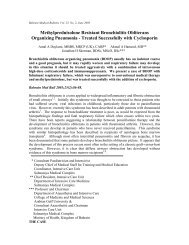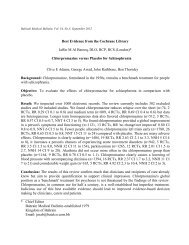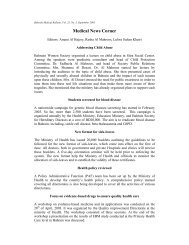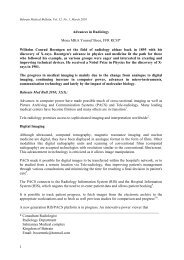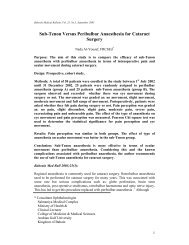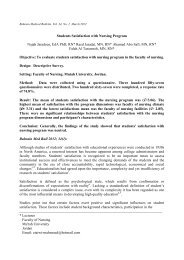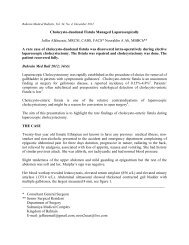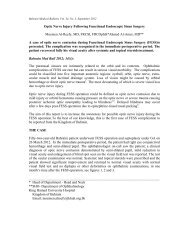Risk factors of Breast Cancer in Bahrain - Bahrain Medical Bulletin
Risk factors of Breast Cancer in Bahrain - Bahrain Medical Bulletin
Risk factors of Breast Cancer in Bahrain - Bahrain Medical Bulletin
Create successful ePaper yourself
Turn your PDF publications into a flip-book with our unique Google optimized e-Paper software.
therefore, <strong>in</strong>creases the relative risk <strong>of</strong> develop<strong>in</strong>g breast cancer 17 . This study revealed<br />
that the average age <strong>of</strong> menarche was 12.7 years; it also revealed that 19% <strong>of</strong> patients had<br />
early menarche (before the age <strong>of</strong> 12 years). The age <strong>of</strong> menarche at 12-13 years old was<br />
47.3% (N=43) and at 14 and above was 30.8% (N=28). Azzena A et al found that the age<br />
<strong>of</strong> menarche was 41.1% under 12 years and 14.1% after 14 years 11 .<br />
Late menopause is another factor lead<strong>in</strong>g to prolonged exposure to the reproductive<br />
hormones; hence, is considered a risk factor for develop<strong>in</strong>g breast cancer 18 . The average<br />
age that women go through menopause is 51 years 19 . In this study, the average age <strong>of</strong><br />
menopause is 48.63 years and the patients who had late menopause (after the age <strong>of</strong> 55<br />
years) were only 2.8%. These data <strong>in</strong>dicate poor correlation between late menopause and<br />
develop<strong>in</strong>g breast cancer <strong>in</strong> this group <strong>of</strong> patients.<br />
The effect <strong>of</strong> parity on reduc<strong>in</strong>g the risk <strong>of</strong> breast cancer has long been recognized. In the<br />
18 th century, Bernado Ramazz<strong>in</strong>i (1633-1714) reported the high rate <strong>of</strong> breast cancer <strong>in</strong><br />
nuns compared with married women and speculated that this might be associated with<br />
their lack <strong>of</strong> children. In a meta-analysis, nulliparity was associated with 30% <strong>in</strong>crease <strong>in</strong><br />
risk compared with parous women 20 . The results <strong>of</strong> our study showed that 19% <strong>of</strong> our<br />
patients were nullipara. This percentage <strong>of</strong> nullipara patients is enough to consider it a<br />
risk factor <strong>in</strong> our patients.<br />
Women with first full term pregnancy after the age <strong>of</strong> 30 have about two to three fold<br />
<strong>in</strong>creased risk <strong>of</strong> breast cancer compared to women hav<strong>in</strong>g a full term pregnancy before<br />
the age <strong>of</strong> 20 years 21 . Our data showed that most <strong>of</strong> our patients were married and had<br />
children at an early age. Eighty-one percent <strong>of</strong> our patients had had children and 75.2%<br />
<strong>of</strong> them had their first child at an early age (less than 30 years).<br />
Lactation is protective aga<strong>in</strong>st breast cancer and the longer a woman breastfeeds, the<br />
greater the protection and the lesser is the risk by 4.3% for each year a woman<br />
breastfeeds 11,18 . However, this study revealed that 74.3% <strong>of</strong> patients had breastfed their<br />
children; this was also found <strong>in</strong> our previous study; therefore, lactation is not an<br />
important risk factor <strong>in</strong> those patients under study.<br />
In a study, it was found that the use <strong>of</strong> oral contraceptive pills slightly <strong>in</strong>creases the risk<br />
<strong>of</strong> breast cancer <strong>in</strong> current and recent users, but there is no significant <strong>in</strong>creased risk after<br />
stopp<strong>in</strong>g its use (ten or more years). These estimates are based on a collaborative analysis<br />
<strong>of</strong> 54 studies <strong>in</strong> 25 countries and data <strong>of</strong> 50,000 women with breast cancer 22,23 . <strong>Cancer</strong><br />
diagnosed <strong>in</strong> woman who had used OCP tends to be less cl<strong>in</strong>ically advanced than those<br />
detected <strong>in</strong> never-user. In this study, oral contraceptive pills were used <strong>in</strong> 20% <strong>of</strong> our<br />
patients. This may support that OCP had some role <strong>in</strong> develop<strong>in</strong>g breast cancer <strong>in</strong> our<br />
patients.<br />
Many studies have shown that the use <strong>of</strong> hormonal replacement therapy was found to<br />
<strong>in</strong>crease the risk <strong>of</strong> breast cancer and reduce the sensitivity <strong>of</strong> mammography 24-,26 . The<br />
risk <strong>of</strong> breast cancer for current or recent users <strong>of</strong> HRT <strong>in</strong>creases by 2% per year <strong>of</strong> use.<br />
In a study, it was shown that risk <strong>in</strong>creases with duration <strong>of</strong> use. For women who had<br />
used it for at least five years (average 11 years) the risk <strong>in</strong>creases to 35% 27 . The effect is<br />
substantially greater for Estrogen-progestagen comb<strong>in</strong>ations than for Estrogen only. In<br />
8





